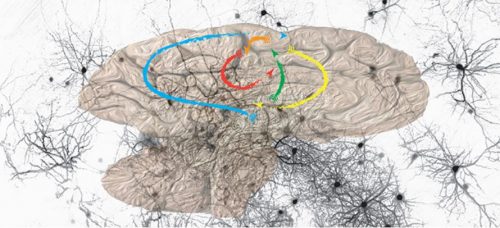Observing how the brain learns by talking to itself could be valuable for AI development, say researchers. Scientists have uncovered the role of synaptic feedback systems in shaping the brain’s learning processes in the cerebral cortex. The cerebral cortex is the outer surface of the brain’s hemispheres. It comprises about 20 billion neurons and carries out the highest levels of mental functioning.
AI or artificial intelligence refers to software that makes robots, computers, and other devices think like human beings. Artificial intelligence also makes them behave like humans.
Much of how the brain learns still a mystery
Humans and other animals possess an extraordinary capacity for learning. That capacity allows for the apprehension of new sensory data to master new skills. It also allows us to adapt to an environment that is forever changing.
However, we have a poor understanding of many of the mechanisms that enable humans and animals to learn.
In systems neuroscience, one of the greatest challenges is to explain how synaptic connections change so our behaviors can adapt.
In a previous study, University of Geneva (UNIGE) neuroscientists showed that synaptic learning mechanisms in the brain’s cortex depend on feedback. Specifically, feedback from deeper regions of the brain.
UNIGE scientists have now deciphered precisely how this feedback gates synaptic strengthening by switching specific inhibitory neurons on and off.
Two UNIGE researchers, Leena E. Williams and Anthony Holtmaat, wrote about their study and findings in the journal Neuron. There is a citation at the end of this article.

How the brain learns – the cortex
The cortex is vital for higher cognitive functions, perception, learning, and complex behaviors. The cortex responds to a sensory stimulus by processing and filtering the data. It does this before passing the most relevant aspects on to other regions of the brain.
Some of these regions, in turn, send data back to the cortex. We call these loops ‘feedback systems.’ Scientists believe they are crucial for the functioning cortical networks and how they adapt to new sensory information.
Study director, Anthony Holtmaat, a Professor in Basic Neurosciences at UNIGE’s Faculty of Medicine, said:
“For perceptual learning – which is the improved ability to respond to a sensory stimulus – neuronal circuits need to first assess the importance of the incoming sensory information and then refine the way it is processed in the future.”
“Feedback systems to a degree confirm that those synapses that were responsible for transmitting the information to other brain areas did this correctly.”
Mouse’s whiskers – highlighting feedback systems
Mice have whiskers that are specialized in tactile sensing. They play an important role in the creature’s ability to comprehend various aspects of its direct environment.
The area in the cortex that processes sensory data from the whiskers continuously optimizes its synapses. It does this so that it can learn new aspects regarding the tactile environment.
It, therefore, constitutes an interesting model for gaining an understanding of the role of feedback systems in synaptic learning mechanisms.
Williams and Holtmaat isolated a whiskers’ related feedback circuit. They measured the electrical activity of the cortex’ neurons using electrodes. The researchers then mimicked the sensory input by stimulating a specific part of the cortex. Neuroscientists know that this part of the cortex processes this information. While doing this, they also used light to control the feedback circuit.
Prof. Holtmaat explained:
“This ex vivo model allowed us to control the feedback independently from the sensory input, which is impossible to do in vivo. However, disconnecting the sensory input from the feedback was essential to understanding how the interplay between the two leads to synaptic strengthening.”
Inhibiting neurons gate the information
Williams and Holtmaat found that both components activate a wide range of neurons when activated separately. When triggered simultaneously, on the other hand, some neurons’ activity actually fell.
First author, Leena Williams, from UNIGE’s Faculty of Medicine, said:
“Interestingly, the neurons that are inhibited when the sensory input and the feedback occur together usually inhibit neurons that are important for perception, this is known as an inhibition of inhibition or a disinhibition.”
“Thus, these neurons act like a gate for the incoming information, and which is normally closed. But when feedback comes in, the gate is opened, allowing those synapses that take care of the primary sensory information to increase their strength.”
“With this study we have identified how feedback possibly optimizes synaptic connections to better prepare for future incoming information.”
The researchers say they want to test their results in ‘real life.’ Then, they can determine whether the inhibiting neurons behave as predicted when a mouse needs to learn new sensory information. They can also confirm what happens when a mouse discovers new aspects of its tactile environment.
Is how the brain learns central to artificial intelligence?
In a press release, the University of Geneva wrote:
“How do brain circuits optimize themselves? How can a system teach itself by reading out its own activity? Apart from being relevant to learning in animals, this question is also at the heart of machine learning programs. Indeed, some deep learning specialists try to mimic brain circuits to build artificially intelligent systems.”
“Insights such as provided by the UNIGE team might be relevant for unsupervised learning, a branch of machine learning that occupies itself with circuit models that are able to self-organize and optimize the processing of new information. This is important for the creation of efficient voice or face recognition programmes, for example.”
Citation
“Higher-Order Thalamocortical Inputs Gate Synaptic Long-Term Potentiation via Disinhibition,” Leena E. Williams and Anthony Holtmaat. Neuron (2018). DOI: https://doi.org/10.1016/j.neuron.2018.10.049.

